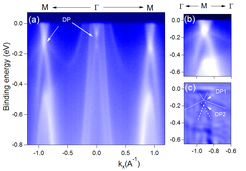The ever expanding family of topological materials: multiple Dirac cones established in LaBi
The discovery of topological materials has created tremendous attention in the scientific community and beyond because these materials can exhibit a novel state of matter in which topologically protected gapless states on their edges or surfaces are present. Such states are protected from scattering by impurities and thus have important technological applications. Last year the Noble Prize in Physics was awarded for theoretical discoveries related to topological phases of matter. One important fingerprint of a topological insulator is a special feature in their electronic structure – a so-called Dirac cone electronic dispersion - that can be probed by the technique of angle resolved photoemission (ARPES). This feature has been observed in many different topological materials that range from Dirac semimetals, to Weyl semimetals. Very recently, the binary rare-earth based monopnictide LaBi has attracted considerable interest due to the exotic magneto-transport properties that it exhibits. In particular, its extremely large and anisotropic magneto-resistance is often seen in topological materials.
Scientists from the Max Plank Institute for Chemical Physics of Solids in Dresden have explored the electronic structure of LaBi and have observed the existence of three Dirac cones: two that coexist at the corner and one at the center of its Brillouin zone. Thus, they have unambiguously proven the topological character of LaBi. Detailed ARPES experiments show that a Dirac cone at the Γ point in the Brillouin zine appears at 150 meV below the Fermi energy where the surface states at the M point are split into two Dirac points at energies of 123 and 198 meV below EF. The surface nature of the Dirac states has been proven from photon energy dependent ARPES measurements, that show that the Dirac points do not change with photon energy. The existence of an odd number of surface Dirac cones originates from the odd number of bulk band inversions thereby confirming the topological origin of the surface states. These findings establish that LaBi is a topological, compensated semimetal, which is equivalent to a time-reversal invariant topological insulator and provides further insight into the topological surface states of LaBi’s semi-metallicity and related magneto-transport properties. With this work the Max Plank Institute for Chemical Physics of Solids has identified one new member of the ever increasing family of topological materials.
JN / CPfS

ARPES measurement and evidence of Dirac cone in LaBi












